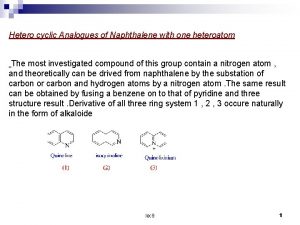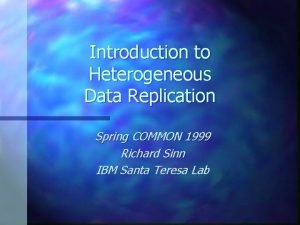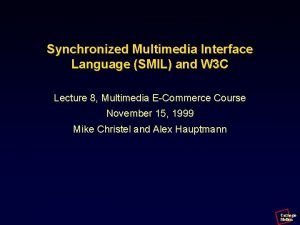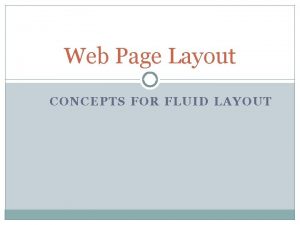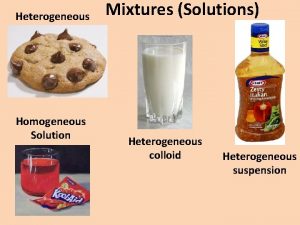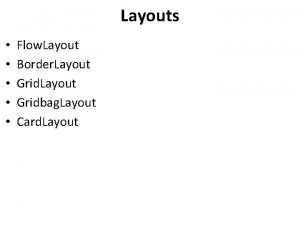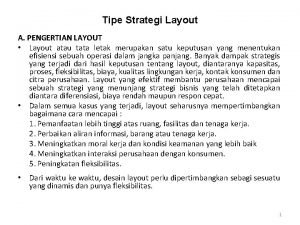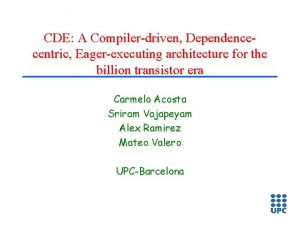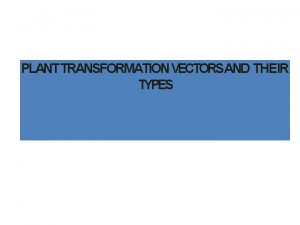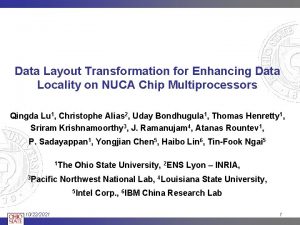CompilerDriven Data Layout Transformation for Heterogeneous Platforms Hetero





![Prefetching on CPU Load A[0] Load B[0] CPU 1 A 0 B 0 L Prefetching on CPU Load A[0] Load B[0] CPU 1 A 0 B 0 L](https://slidetodoc.com/presentation_image_h2/bfcaeddc93b976df25cbceda677eb351/image-6.jpg)
![Coalescing on GPU Load A[0 -15] Load B[0 -15] Load C[0 -15] SM 1 Coalescing on GPU Load A[0 -15] Load B[0 -15] Load C[0 -15] SM 1](https://slidetodoc.com/presentation_image_h2/bfcaeddc93b976df25cbceda677eb351/image-7.jpg)




















- Slides: 27

Compiler-Driven Data Layout Transformation for Heterogeneous Platforms Hetero. Par'2013 Deepak Majeti 1, Rajkishore Barik 2 Jisheng Zhao 1, Max Grossman 1, Vivek Sarkar 1 1 Rice University, 2 Intel Corporation 1

Acknowledgments • I would like to thank the Habanero team at Rice University for their support. • I would also like to thank the reviewers for their valuable feedback. 2

Introduction Heterogeneity is ubiquitous – both in client as well and server domains Portability and Performance 3

Motivation • How does one write portable and performant programs? • How do we port existing application to the newer hardware? – This is a hard problem. – Example: A CPU has different architectural features compared to a GPU. Need high level language constructs, efficient compiler and runtime frameworks 4

Motivation • Each processor has a different memory(cache) hierarchy • Each memory hierarchy demands a different data layout – CPU performs well with a struct layout because of prefetching – GPU performs well with an array layout because of coalescing – In our experiments, the layout impacted the performance of one application by a factor of 27. Need to automatically map data structures 5
![Prefetching on CPU Load A0 Load B0 CPU 1 A 0 B 0 L Prefetching on CPU Load A[0] Load B[0] CPU 1 A 0 B 0 L](https://slidetodoc.com/presentation_image_h2/bfcaeddc93b976df25cbceda677eb351/image-6.jpg)
Prefetching on CPU Load A[0] Load B[0] CPU 1 A 0 B 0 L 1 cache Load A[4] Load B[4] CPU 2 A 4 B 4 L 1 cache Load A[0] Load B[0] CPU 1 Load A[4] Load B[4] CPU 2 A 0 B 0 A 4 B 4 L 1 cache 2 Loads/processor 1 Load/processor A 0 A 1 A 2 A 3 A 4 A 0 B 0 A 1 B 1 A 2 B 0 B 1 B 2 B 3 B 4 B 2 A 3 B 3 A 4 B 4 Main Memory Without Prefetching With Prefetching 6
![Coalescing on GPU Load A0 15 Load B0 15 Load C0 15 SM 1 Coalescing on GPU Load A[0 -15] Load B[0 -15] Load C[0 -15] SM 1](https://slidetodoc.com/presentation_image_h2/bfcaeddc93b976df25cbceda677eb351/image-7.jpg)
Coalescing on GPU Load A[0 -15] Load B[0 -15] Load C[0 -15] SM 1 Load A[16 -31] Load B[16 -31] Load C[16 -31] SM 2 A[0 -15] B[0 -15] C[16 -31] A[16 -31] B[16 -31] C[0 -9] A[11 -15] A[0 -10] B[0 -10] C[10 -15] B[11 -15] L 1 cache B[27 -31] A[16 -26] C[26 -31] B[16 -26] C[16 -25] L 1 cache 3 64 -byte Loads/SM 128 -byte Load 3 64 -byte Loads, 3 128 -byte Loads/SM A[0 -15] A[16 -31] A[11 -15] C[0 -9] B[11 -15] C[10 -15] [ABC][0 -15] A[0 -10] B[0 -15] B[16 -31] [ABC][16 -31] A[16 -26] A[27 -31] B[16 -26] B[27 -31] C[26 -31] C[16 -25] C[0 -15] C[16 -31] Coalesced Access Non-Coalesced Access 7

Our Approach • Restrict data structures in programming model so that they can be implemented with different data layouts without changing the program semantics • We propose a compiler driven meta-data layout framework to abstract away the data layout from the program. – Auto-tuner / expert programmer specifies the metadata file. – A metadata file contains a high level view of the data layout. – Compiler auto-generates the program based on the metadata for the target architecture. 8

Overall Framework 9

Habanero-C forasync Multidimentional Parallel Loop Construct forasync point (args) size (args) seq (args) { Body } • • • Loop indices in each dimension are specified by the point clause. The number of iterations in each dimension is specified by the size clause. The tile size is specified by the seq clause • forasync is compiled to Open. CL (CPU and GPU). • forasync can also be compiled to Habanero-C runtime for CPUs only Full details are available at https: //wiki. rice. edu/confluence/display/HABANERO/Habanero-C 10

forasync to Open. CL kernel int main(){ …………… forasync point(i, j) size(M, N) seq(tilesize 1, tilesize 2) { a[i * M + j] = b[i * M + j] + c[ i * M + j]; } ……………. } void offload(float *a, float *b, char *kernel_name, char* ocl_kernel) { //Build the kernel //copy data from host to the device buffer //execute the kernel //copy data back from the device to host buffer. . } int main(){ offload(a, b, c, ”kernel_1”, Kernel_string); } Kernel_string=“ void kernel_1(__global float *a, __global float *b, __global float *c, int M, int N) { i = get_global_id(1); j = get_global_id(0); a[i * M + j] = b[i * M + j] + c[ i * M + j]; } “; 11

Metadata layout framework Algorithm • Auto-tuner/ expert programmer specifies a layout schema 1. Create data structure definitions. 2. For every function definition whose formal parameters belong to the schema, replace with the corresponding data structure in the schema. 3. For every instruction, update the reference of such formal parameter with the new data structure reference. 12

Metadata Framework Example int main(){ forasync point(i, j) size(M, N) seq(tilesizeq 1, tilesize 2) { a[i * M + j] = b[i * M + j] + c[ i * M + j]; } } struct ABC{float a, float b, float c}; void offload(struct ABC *abc, char *kernel_name, char* ocl_kernel) { //Open. CL Host Code. . } int main(){ struct ABC *abc = ………… offload(abc, ”kernel_1”, Kernel_string); } Arch Intel_CPU Struct ABC Field fp a Field fp b Field fp c Kernel_string=“ struct ABC{float a, float b, float c}; void kernel_1(__global struct ABC *abc, int M, int N) { i = get_global_id(1); j = get_global_id(0); abc[i * M + j]. a = abc[i * M + j]. b + abc[ i * M + j]. c; } “; 13

Metadata Framework Example int main(){ forasync point(i, j) size(M, N) seq(tilesize, tilesize) { a[i * M + j] = b[i * M + j] + c[ i * M + j]; } } struct AB{float a, float b}; void offload(struct AB *ab, float * c, char *kernel_name, char* ocl_kernel) { //Open. CL Host Code. . } int main(){ struct AB *ab = ………… offload(ab, c, ”kernel_1”, Kernel_string); } Arch AMD_CPU Struct AB Field fp a Field fp b Kernel_string=“ struct AB{float a, float b}; void kernel_1(__global struct AB *ab, __global float *c, int M, int N) { i = get_global_id(1); j = get_global_id(0); ab[i * M + j]. a = ab[i * M + j]. b + c[ i * M + j]; } “; 14

Metadata layout framework Current Limitations • The transformation depends upon the names of the fields. – One can use a smart variable renaming scheme • Assumes a strongly typed program. – Pointer manipulations are hard to transform between layouts • Cannot handle pointer swaps between fields of different layout groups 15

Benchmarks Name Description Original Layout Num of Fields Input NBody N-Body Simulation SOA 7 32 K nodes Medical Imaging Image Registration SOA 6 256 x 256 SRAD Speckle Reducing Anisotropic Diffusion SOA 4 5020 x 4580 Seismic Wave Simulation SOA 6 4096 x 4096 MRIQ Matrix Q Computation for 3 D Magnetic Resonance Image Reconstruction in Non-Cartesian Space SOA 6 64 x 64 16

Experimental Setup Vendor Type Model Freq Cores L 1$ L 2$ Intel CPU X 5660 2. 8 GHz 12(HT) 192 KB 1. 5 MB Intel Integrated GPU I 7 -3770 U 1. 15 GHz 14 N. A NVIDIA Discrete GPU Tesla M 2050 575 MHz 8 128 KB 768 KB AMD CPU A 10 -5800 K 1. 4 GHz 4(HT) 192 KB 4 MB AMD Integrated GPU Radeon HD 7660 800 MHz 6 N. A 17

Experimental Methodology • Timing – Minimum time over 5 runs • Normalized Time – Layouts are compared to the fastest layout implementation on each architecture. • Overheads – Data communication – Open. CL kernel creation/ launching • Layouts – AOS: Array of Structures – SOA: Structure of Arrays – AOS 1: Intermediate Hybrid representation 18

Experimental Results Medical Imaging benchmark • Array of structures (AOS) is better for the CPUs. – Kernel benefits from spatial locality • Structure of arrays (SOA) is better for the GPUs. – Due to coalescing 19

Experimental Results Seismic benchmark • Array of structures(AOS) is better for the AMD CPU. – Possibly due to cache associativity on CPUs • Structure of arrays(SOA) is better for the INTEL CPU and GPUs. – Coalescing for GPUs 20

Experimental Results MRIQ benchmark • Data layout play no role in performance on CPUs and GPUs. – Kernel is compute bound. 21

Experimental Results NBody benchmark • AOS better for GPUs. – Coalescing • Data layout plays no role in performance on CPUs. – No gain from spatial locality. 22

Experimental Results SRAD benchmark • Array of Structures (AOS) is best on AMD GPU. • Intermediate Array of Structures (AOS 1) is best on all the other platforms. – The non-affine accesses in the kernel make it hard to predict the correct layout. 23

Conclusion • Different architectures require different data layouts to reduce communication latency. The meta-data layout framework helps bridge this gap. • We extend Habanero-C to support a meta-data layout framework. – Auto-tuner / expert programmer specifies the metadata file. – Compiler auto-generates the program based on the meta data for the target architecture. • The meta-data framework also helps take advantage of the various scratchpad memory available on a given hardware. 24

Future Work • Come up with auto-tuning frameworks and heuristics to automatically determine the layouts on a specific hardware. 25

Related Work • Data Layout Transformation Exploiting Memory-Level Parallelism in Structured Grid Many-Core Applications. Sung et. al. , PACT 10 – Change indexing for memory level parallelism • DL: A data layout transformation system for heterogeneous computing. Sung et. al. , In. Par’ 12. – Change the data layout at runtime • Dymaxion: optimizing memory access patterns for heterogeneous systems, Che et al. , SC ’ 11 – runtime iteration space re-ordering functions for better memory coalescing • TALC: A Simple C Language Extension For Improved Performance and Code Maintainability. Keasler et. al. , Proceedings of the 9 th LCI International Conference on High-Performance Clustered Computing – Only for CPUs and focus on meshes 26

Thank you 27
 Hétéro sondage
Hétéro sondage Hetero sugesti
Hetero sugesti Holozoik beslenme
Holozoik beslenme Hetero hypno
Hetero hypno Oral hetero
Oral hetero Hetero atom
Hetero atom Trtnt
Trtnt Chapter 9 medical terminology
Chapter 9 medical terminology Heterogeneous data replication
Heterogeneous data replication Heterogeneous data integration
Heterogeneous data integration Numerator layout vs denominator layout
Numerator layout vs denominator layout Smil head layout root-layout
Smil head layout root-layout Mpeg-1
Mpeg-1 Fixed layout website example
Fixed layout website example Fspos
Fspos Novell typiska drag
Novell typiska drag Tack för att ni lyssnade bild
Tack för att ni lyssnade bild Vad står k.r.å.k.a.n för
Vad står k.r.å.k.a.n för Varför kallas perioden 1918-1939 för mellankrigstiden
Varför kallas perioden 1918-1939 för mellankrigstiden En lathund för arbete med kontinuitetshantering
En lathund för arbete med kontinuitetshantering Personalliggare bygg undantag
Personalliggare bygg undantag Personlig tidbok
Personlig tidbok A gastrica
A gastrica Förklara densitet för barn
Förklara densitet för barn Datorkunskap för nybörjare
Datorkunskap för nybörjare Tack för att ni lyssnade bild
Tack för att ni lyssnade bild Mall för debattartikel
Mall för debattartikel Delegerande ledarstil
Delegerande ledarstil





